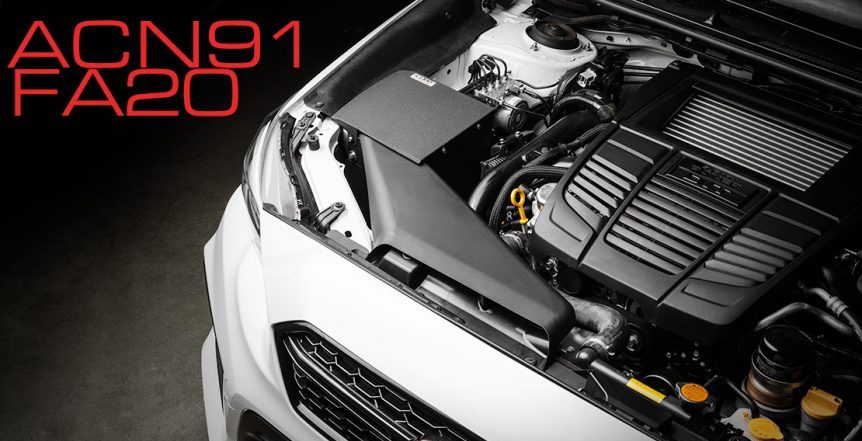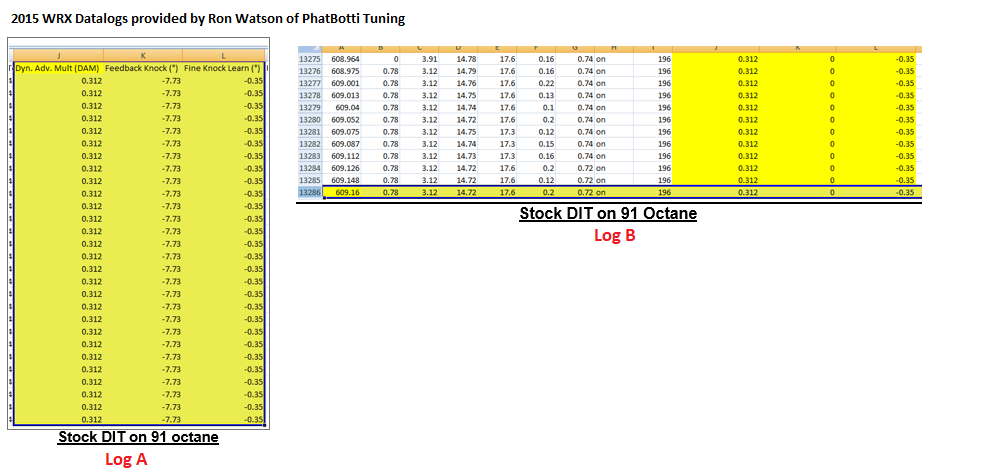DIT WRX/FXT ACN91 MAPS?

Hey, why isn’t there an ACN91 tune for the 2015+ WRX and 2014+ FXT? Great Question!
With Subarus using the EJ platform, we’ve always made a variation of each OTS map for 93, 91, and ACN91 octane fuels. We want to make sure to take good care of our west coast homies despite their less than ideal fuel options. Yet, many people have noticed we don’t have an ACN91 tune for the cars that use the FA platform. Don’t worry, we haven’t abandoned you. Things just work a little different on the latest direct injected engine design from Subaru.
In short, we felt that making an aftermarket tune specifically for ACN91 in a broadly used OTS variant simply isn’t necessary.
To understand why, we actually need to start by looking at how the car behaves from the factory. The FA engines have a higher compression ratio (10.6:1) compared to their older EJ brethren (8.0:1 – 9.5:1). Also, the EGR system tends to greatly elevate intake manifold air temperatures. The combination of those two factors is a recipe that leads to greater potential for knock. Naturally, the benefit is improved efficiency and power, but the trade-off is that the ECU has to play a more active role in finding the proper balance with ignition timing so that fuel efficiency and emissions are not sacrificed while walking that tight line between proper combustion and knock.

Log A above shows what knock looks like on the stock tune on ACN91 octane. You can see that the Dynamic Advance Multiplier (DAM) is down to 0.312 from 1.0. This means that the car is only running 30% of the ignition advance because it is knocking so badly. And the car is also pulling -7* Feedback Knock Correction and a little Fine Knock Learning. In Log B, we see the end of a 5-minute datalog that shows a total of 13,286 lines of knock. Again, this shows how poorly the cars run on the stock tune and how insignificant the corrections commonly seen on a COBB OTS tune are by comparison.
Ultimately, with higher quality fuel, the ECU doesn’t have to work too hard, but there is a sharp increase in the amount of adaptation that needs to occur when ACN91 is in the tank. That sounds a little scary, but don’t worry, it’s actually good news. Along with the updated engine design, Subaru upgraded the ECU and also added a second physical knock sensor. So it is more than capable of quickly and accurately monitoring and adjusting the behavior of the engine across varying fuel qualities. On the stock tune from Subaru, the car rarely runs at “full” timing values even on 93 octane. Global adjustments to timing (via DAM) are consistently applied and considered as normal behavior. In the past, that would be quite a red flag but it’s just the nature of the beast in this case.
So what does that all mean in regards to the COBB OTS maps?
You may have already started to put two and two together. Because of the improved ECU ability, we are able to make a single “91 Octane” map that is applicable to ACN91 as well as any other 91 octane from top tier stations. If you are lucky and have very high quality 91 octane fuel, then when you install the Accessport to the correct map the car may be able to run at full timing and make the most possible power for that configuration. On the other hand, if you are not so lucky and have 91 rated fuel that isn’t quite on the same level, our calibration can actively “nip and tuck” when needed to make sure it doesn’t exceed safe parameters.
Another way to look at it is that because of the advanced abilities of the ECU and our high-level understanding of how to scale and calibrate the tables that are affected by fuel quality, we are essentially able to make a single tune that can generally self-govern across a broader range of fuel quality. Whereas with the older ECU and EJ engine. The best option was to actually create entirely separate tunes.
***IMPORTANT NOTE***
A common misunderstanding is that because the ECU/Tune have the ability to adapt to varied fuel qualities, sometimes people falsely assume that they can be more liberal with the fuel they use. There is never a time where it is okay to use octane below the rating the tune was designed for. So just because the ECU can reduce timing does not mean that it will be able to properly handle 89 or 87 octanes or even 91 from low tier fuel stations. It may save a few bucks in the short term, but I assure you it will cost you in the future.
Additional Related Information:
Data Logging Overview
2015 DIT WRX – DAM and Knock Corrections
Subaru knock control strategy

im currently running the 91 octane lwg tune for the sf+ intake and im have DAM issues. are there any tips for raising the dam again after its dropped. i don’t want more power i just want reliablity
Hey Kai! First, make sure you have the correct map flashed – we do offer both a +Big SF and +SF variant of that map for your car so it is easy to confuse. After you have confirmed that, the easiest way to get DAM to learn back up is to ensure you are operating in load ranges where timing corrections favorable (no negative timing corrections). Some steady driving in that area should help DAM learn back up to 1.
Marshall@COBB